
All fruits and vegetables have ways of telling us exactly when they taste best, even before we’ve picked them. As I was picking blackberries this morning, I found myself explaining to my 2-year-old how to select the darkest and fattest ones that fall off easily into your hands. Learning to recognize these signs takes practice, however. Even the most experienced gardeners might need several tries before they can capture that brief moment between the time a not quite ready melon tastes bland and when it is sickeningly overripe. Just yesterday, I picked my first tomato of an heirloom variety that I hadn’t grown for several years. I’d forgotten how deep a shade of orange it eventually becomes and picked it too yellow — it tasted sour and nothing like the wine-like sweetness I remembered.
Many factors affect flavor in your vegetables: seed variety, soil type, temperature, season, amount of water, sunlight, and whether they are grown outdoors or in a greenhouse. At harvest time, however, the most important things to consider are time of day, and ripeness. The following harvesting information should help you pick your vegetables when they are at their best.
In summertime, the farmers at our local market get up well before sunrise to start picking as soon as there’s enough light to see. Now I'm not much of an early bird, but it's true that with few exceptions, vegetables are best harvested in the cool morning hours so that they stay crisp and store longer. If harvested too late, they become limp and wilt quickly, having evaporated much of their moisture and absorbed the midday heat. This is especially important for leafy greens like lettuce, chard and fresh herbs such as parsley and basil. It also applies to crisp fruiting vegetables like peas, and anything in the cabbage family like broccoli and radishes.
If a morning harvest is impossible to fit into your schedule or lifestyle, pick in the evening after the heat of the late afternoon sun has begun to wane. Other fruiting vegetables, such as tomatoes, peppers and zucchini are less sensitive to wilting, so they can be picked later in the day. So can root vegetables like carrots, but make sure to get them out of the sun and into the refrigerator quickly, particularly if the weather is warm.
Testing for ripeness involves all the senses: from tapping and smelling melons to puncturing corn kernels and recognizing the perfect plumpness of a pea! After enough practice and plenty of tasting, you’ll find that your hands learn to find beans of the perfect thickness on their own.
Harvesting Tips
 Beets: Pick baby beets at 1 1/2 inches diameter and let some grow larger. For best flavor in hot weather, keep beets well watered and don’t leave them in the ground so long that they become pithy or woody.
Beets: Pick baby beets at 1 1/2 inches diameter and let some grow larger. For best flavor in hot weather, keep beets well watered and don’t leave them in the ground so long that they become pithy or woody.Broccoli: Harvest broccoli in the morning, when the heads are large and fully developed. The buds should be tightly closed; they eventually start to
 expand and open into yellow flowers, but if you wait until that point, your broccoli will be tough and woody. Cut the plant about halfway down the stalk to encourage the continual production of side shoots. Keep plants well watered to prevent them from developing a bitter or sulphuric taste. The best tasting broccoli is produced in cool weather.
expand and open into yellow flowers, but if you wait until that point, your broccoli will be tough and woody. Cut the plant about halfway down the stalk to encourage the continual production of side shoots. Keep plants well watered to prevent them from developing a bitter or sulphuric taste. The best tasting broccoli is produced in cool weather.
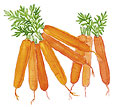 Carrots: Pull carrots after they’ve developed a rich orange or yellow color, depending on the variety. If your carrot tops break off when you pull them, try loosening the soil first with a digging fork. Baby carrots can be picked when they are 1/2 inch thick. Pick round carrots when they are 1 to 1 1/2 inches in diameter.
Carrots: Pull carrots after they’ve developed a rich orange or yellow color, depending on the variety. If your carrot tops break off when you pull them, try loosening the soil first with a digging fork. Baby carrots can be picked when they are 1/2 inch thick. Pick round carrots when they are 1 to 1 1/2 inches in diameter.
 Chard: Harvest the outer leaves of chard when the plants are sturdy and well established. Be sure to leave four to six leaves so that the plant can continue to grow and produce more leaves throughout the summer. Chard will also overwinter in mild areas where the ground does not freeze hard.
Chard: Harvest the outer leaves of chard when the plants are sturdy and well established. Be sure to leave four to six leaves so that the plant can continue to grow and produce more leaves throughout the summer. Chard will also overwinter in mild areas where the ground does not freeze hard.
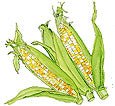 Corn: Corn is ready when the ears become rounded at the base and the silks at the top turn dark brown but haven’t yet dried out. Peel back the ear to expose the cob and puncture a kernel with your fingernail. If the kernels are fat and juice is milky-white, the ear is ready for eating. For best results, pick and shuck corn ears close to the time you want to eat it, sugar enhanced varieties keep their sweetness longer. Convenient if you can’t eat all your ripe corn at once!
Corn: Corn is ready when the ears become rounded at the base and the silks at the top turn dark brown but haven’t yet dried out. Peel back the ear to expose the cob and puncture a kernel with your fingernail. If the kernels are fat and juice is milky-white, the ear is ready for eating. For best results, pick and shuck corn ears close to the time you want to eat it, sugar enhanced varieties keep their sweetness longer. Convenient if you can’t eat all your ripe corn at once!
 Cucumbers: Harvest English and Middle Eastern cucumbers when they’ve grown to size, the skin is smooth and glossy and the seeds are small. Don’t wait too long! Bigger is not better in cukes and pick at least every other day, since over-mature cucumbers become bitter and unpleasantly seedy. Frequent picking also increases production of new fruits. Harvest lemon cucumbers when they are light green with just a blush of lemon color. They taste less crisp and much too seedy if you wait until they turn bright yellow.
Cucumbers: Harvest English and Middle Eastern cucumbers when they’ve grown to size, the skin is smooth and glossy and the seeds are small. Don’t wait too long! Bigger is not better in cukes and pick at least every other day, since over-mature cucumbers become bitter and unpleasantly seedy. Frequent picking also increases production of new fruits. Harvest lemon cucumbers when they are light green with just a blush of lemon color. They taste less crisp and much too seedy if you wait until they turn bright yellow.
 Eggplant: Pick eggplants when they have grown to size and are smooth and shiny. They taste most delicate and least bitter when they are still young, before the skins toughen and the seeds mature and darken inside. To avoid damaging the easily breakable plants, be sure to cut the fruits from the branches, rather than trying to pull off the eggplants.
Eggplant: Pick eggplants when they have grown to size and are smooth and shiny. They taste most delicate and least bitter when they are still young, before the skins toughen and the seeds mature and darken inside. To avoid damaging the easily breakable plants, be sure to cut the fruits from the branches, rather than trying to pull off the eggplants.
 Fennel: Cut bulbing fennel at soil level when the bulbing base becomes knobby and rounded and about 3/4 the size of a tennis ball or larger. After harvesting each bulb, cut the ferny leaves down to the stalk, then slice up the juicy bulb to use fresh or cooked.
Fennel: Cut bulbing fennel at soil level when the bulbing base becomes knobby and rounded and about 3/4 the size of a tennis ball or larger. After harvesting each bulb, cut the ferny leaves down to the stalk, then slice up the juicy bulb to use fresh or cooked.
 Salad and Stir-Fry Greens: Mixed greens such as mesclun salads, stir-fry greens or lettuce mixes can be picked as tiny 2 inch baby thinnings. Otherwise, use the "Cut and Come Again" method: wait until the young plants are just 4 to 7 inches tall: then cut across the whole bed with a scissors to harvest, leaving the bottom 1 to 2 inches of plants in the soil. Water well, and fertilize lightly. The cut crowns of the plants will regrow for successive harvests. These mixed greens can sometimes taste bitter after several cuttings, particularly in very hot weather, so make successive sowings every few weeks for a constant supply of tender young leaves. Spicier leaves like arugula, taste mildest in cool spring or fall weather.
Salad and Stir-Fry Greens: Mixed greens such as mesclun salads, stir-fry greens or lettuce mixes can be picked as tiny 2 inch baby thinnings. Otherwise, use the "Cut and Come Again" method: wait until the young plants are just 4 to 7 inches tall: then cut across the whole bed with a scissors to harvest, leaving the bottom 1 to 2 inches of plants in the soil. Water well, and fertilize lightly. The cut crowns of the plants will regrow for successive harvests. These mixed greens can sometimes taste bitter after several cuttings, particularly in very hot weather, so make successive sowings every few weeks for a constant supply of tender young leaves. Spicier leaves like arugula, taste mildest in cool spring or fall weather.
"Winter" Greens:
 Endive and Escarole: Plant these greens in mid to late summer for a fall harvest. Cut whole heads of endive and escarole when they begin to fill with lighter leaves in the center. Some gardeners tie or rubber band the outer leaves around the center and leave them closed for about a week to blanch and sweeten leaves inside. Cold-weather makes these leafy greens even more crispy-sweet and succulent.
Endive and Escarole: Plant these greens in mid to late summer for a fall harvest. Cut whole heads of endive and escarole when they begin to fill with lighter leaves in the center. Some gardeners tie or rubber band the outer leaves around the center and leave them closed for about a week to blanch and sweeten leaves inside. Cold-weather makes these leafy greens even more crispy-sweet and succulent.
Radicchio: Cut the inner heads of radicchio in late fall before a hard frost when they are firm, round and colored deep red and white. If you pick them too early when leaves are still red and green, they will taste quite bitter.
 Kale: You can start picking the outer leaves of kale when the plants are sturdy and well established. Be sure to leave seven or eight leaf crowns to regrow after harvest.
Kale: You can start picking the outer leaves of kale when the plants are sturdy and well established. Be sure to leave seven or eight leaf crowns to regrow after harvest.
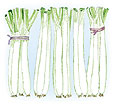
Leeks: Harvest tender baby leeks when they are about 1/2 to 1 inch thick or continue to let them thicken. Make sure to pick them before they begin to send up a flowering stalk, or they’ll be much too tough to eat. Keep leeks well weeded, watered and fertilized, and hill up the soil around the base for a longer, blanched white shaft, which is more delicate than the tougher green upper leaves.
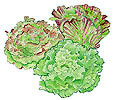 Lettuce: Pick lettuce in the cool early morning while they leaves are still crisp. Lettuce can be harvested as delicate baby greens, or as crisp, full-bodied heads. To harvest by the "Cut and Come Again," method, cut with a scissors when lettuces reach about 4 to 5 inches tall to about 2 inches above the soil line. Water well and fertilize lightly to enjoy several additional cuttings. Harvest whole heads of lettuce when they start to fill in at the center but before they begin to elongate at the center and "bolt" (send up a flower stem), at which point they’ll taste bitter.
Lettuce: Pick lettuce in the cool early morning while they leaves are still crisp. Lettuce can be harvested as delicate baby greens, or as crisp, full-bodied heads. To harvest by the "Cut and Come Again," method, cut with a scissors when lettuces reach about 4 to 5 inches tall to about 2 inches above the soil line. Water well and fertilize lightly to enjoy several additional cuttings. Harvest whole heads of lettuce when they start to fill in at the center but before they begin to elongate at the center and "bolt" (send up a flower stem), at which point they’ll taste bitter.
 Melons: The perfection of a melon is so fleeting, that finding a perfectly ripe melon every time is a fine art. Pay close attention when picking so you learn what factors indicate the tastiest fruits. If you consistently have trouble growing tasty melons in your area, it may be that your climate is too cool. Grow them on black plastic or over a rock wall, and experiment with different varieties to find the best for your region.
Melons: The perfection of a melon is so fleeting, that finding a perfectly ripe melon every time is a fine art. Pay close attention when picking so you learn what factors indicate the tastiest fruits. If you consistently have trouble growing tasty melons in your area, it may be that your climate is too cool. Grow them on black plastic or over a rock wall, and experiment with different varieties to find the best for your region.Cantaloupes: Pick when they heavy and tan-colored with a slight yellowish cast. When ripe, a cantaloupe’s netting becomes harder and raised, and a crack forms around the stem where it touches the fruit. The melons should slip easily off the vines with a quick pull, but should not have already fallen off. The fruits get slightly softer at the bottom end and they smell fragrant.
Honeydews: They should have a slight yellow blush on their ivory rinds when ready. They also get slightly softer at the blossom end. Unlike muskmelons, honeydews do not slip off at the stem so must be cut from the vines.
Galia Melons: Galia melons turn from green to a golden color on the surface of the fruits and smell fragrant.
Watermelons: Pick when they develop a dull green cast and have a light patch at the bottom that changes from green to light yellow when mature. Also, the leaf on the tendril nearest the fruit turns brown and withers. The skin should be hard and difficult to pierce with a fingernail. Some people say they can knock on a melon to detect a perfect hollow tone.

Peas: Pick peas in the morning at least every other day for maximum harvest and crispest texture.
Shelling Peas: Pick them when the pods are rounded and the peas have filled the pod but before they grow too large and tough.
Snap Peas: Wait until the flat edible pods begin to grow rounded, plump and juicy but before the peas inside get too big and tough. You’ll notice that the pods will not taste sugary enough if the pods are picked too early and flat.
Snow Peas: Pick them when the pods have grown to size but are still quite flat.
Peppers: Sweet peppers taste much sweeter and are most nutritious when they’ve been allowed to fully color up from green to glowing red, orange or yellow on the vine, depending on variety. If your growing season is too short for peppers to ripen completely, pick your last green peppers as late as possible and keep in a cool
 place to color up, checking them often for rotting. Chile peppers also develop their full pungency and fruitiness when fully colored, but can be harvested shiny green as soon as they’ve grown to size.
place to color up, checking them often for rotting. Chile peppers also develop their full pungency and fruitiness when fully colored, but can be harvested shiny green as soon as they’ve grown to size.
Pumpkins: Harvest pumpkins when the fruits are deep orange and the shells are so hard that they can’t be pierced with a fingernail. Cut a 2 to 3 inch stem handle, let cure for 10 days in the sun or a warm, dry room (do not expose to frost) and store in a cool, dry place at around 50 degrees.
Squash:
Summer Squash: Smaller is better when it comes to summer squash. The longer the fruits remain on the vine, the tougher on the outside, seedier and more watery they become on the inside. Even the most ardent zucchini bread bakers will probably not want to grate and freeze too many baseball-bat sized fruits! So pick zucchini no larger than 6 or 7 inches. Pick patty pan squash at 2 to 3 inches, round zucchini at 3 to 4 inches, and longer Trombetta squash at 12 to 14 inches.
Winter Squash: Pick winter squash when rind is deeply colored and the shells have become so hard that you can’t pierce them with your fingernail. Cut a 2 to 3 inch stem handle, let cure for 10 days in the sun or a very warm room (do not expose to frost) and store in a cool dry place at around 50 degrees. Some varieties which store less well such as acorn squash should be consumed in the fall; the flavor and texture of many other varieties such as Kabocha and Butternut improves in storage.
Spinach: Spinach grows best in cool weather. To harvest by the "Cut and Come Again," method, cut young spinach when it is about 5 to 6 inches tall to about 1 inch above the soil line and plants will regrow for another cutting. Or you can start harvesting outer leaves as soon as the plants have at least 5 to 6 full-size
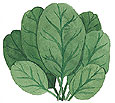 leaves, always leaving at least 4 to 5 leaves on the plant so it can regrow hardily. By harvesting frequently with one of these methods, you will extend the period in which the plant produces leaves before it sends up a flower stem and bolts.
leaves, always leaving at least 4 to 5 leaves on the plant so it can regrow hardily. By harvesting frequently with one of these methods, you will extend the period in which the plant produces leaves before it sends up a flower stem and bolts.
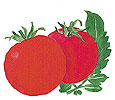 Tomatoes: For best sun-ripened flavor, pick tomatoes when they are richly colored and have no trace of green on the skin. If, however, you are experiencing alternately wet and dry weather and are concerned about cracking of thin-skinned heirlooms, you can pick them when they are just blushed with color and let them ripen indoors (not in the refrigerator). Tomatoes taste best where days and nights are warm. Otherwise delicious varieties can taste bland where nights are cool or in years when the sun refuses to shine! For best flavor and texture, do not store ripe tomatoes in the refrigerator. (I like to pile them in a big colorful bowl or basket and use as a kitchen centerpiece).
Tomatoes: For best sun-ripened flavor, pick tomatoes when they are richly colored and have no trace of green on the skin. If, however, you are experiencing alternately wet and dry weather and are concerned about cracking of thin-skinned heirlooms, you can pick them when they are just blushed with color and let them ripen indoors (not in the refrigerator). Tomatoes taste best where days and nights are warm. Otherwise delicious varieties can taste bland where nights are cool or in years when the sun refuses to shine! For best flavor and texture, do not store ripe tomatoes in the refrigerator. (I like to pile them in a big colorful bowl or basket and use as a kitchen centerpiece).